![]()
![]()
![]()
Use LEFT and RIGHT arrow keys to navigate between flashcards;
Use UP and DOWN arrow keys to flip the card;
H to show hint;
A reads text to speech;
12 Cards in this Set
- Front
- Back
|
Quadratus Lumborum: Costal Fibers
•Origin: Iliac Crest (Posterior/Superior ¼) & Iliolumbar Ligament •Insertion: 12th Rib (Posterior/Inferior Border) Quadratus Lumborum: Spinal Fibers •Origin: Iliac Crest (Posterior/Inferior ½) •Insertion: L1 – L4 TP’s Quadratus Lumborum: Function •Considered by some to be a deep abdominal muscle. Lies under the back muscles and under the deepest abdominal muscles. •Unilateral Function: Laterally flexes the lumbar spine, elevates pelvis on the same side in the standing position, & rotates the spine to the opposite side. •Bilateral Function: Extension of the lumbar spine. •Along with the psoas and iliacus muscles, the QL is a stabilizer of the pelvis and lumbar spine. •Key function in lumbo-pelvic mechanics. •Lies deep to the erector spinae and thoracolumbar fascia. •Frontal plane guy wire with the hip abductors and adductors. •Role with the Iliolumbar ligament. •Lateral bending to the same side with pelvis fixed. •Hip hike with rib cage fixed. •Moves and stabilizes the pelvis and lumbar spine in the frontal plane. •Fixation and depression of 12th rib. •Controls torsional stress in the lumbar spine. •If weak: can stress the other lateral flexors and rotators of the trunk & spine. |
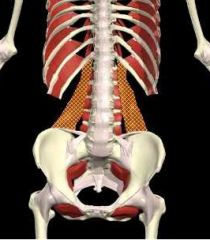
Spinal Muscles:
Quadratus Lumborum |
|
|
Spinalis: Lumborum
•Origin: Sacral SP’s •Insertion: L1 – L3 SP’s Spinalis: Thoracis •Origin: L3 – T10 •Insertion: T2 – T8 Spinalis: Function •The deep erector muscles closest to the middle of the spine are called the spinalis muscles. Vertical muscle. •Bilateral Function: Spinal Extension •Unilateral Function: Lateral flexion of the spine & rotation of the spine to the opposite side. •If weak, can stress the other spinal muscles and create tension in the abdominal muscles. |
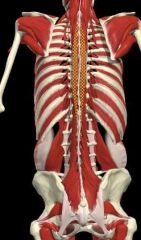
Spinal Muscles:
Spinalis |
|
|
Semispinalis Thoracis: Attachments
•Origin: T1 – T12 TP’s •Insertion: T12 – C4 SP’s Semispinalis Thoracis: Function •Bilateral Function: Extends spine & head. •Strong stabilizers of the vertebral column. •The Transversospinalis group is deep to the erector spinae group, and is comprised of the – multifidi, rotatores, and semispinalis. This group consists of short, diagonal fibers that form a stitch like pattern linking the vertebrae together. •If weak, can stress the other spinal muscles and create tension in the abdominal muscles and anterior cervical muscles. |
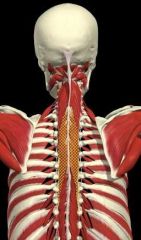
Spinal Muscles:
Semispinalis Thoracis |
|
|
Multifidus: Lumbo-Sacral
•Origin: Sacrum (SP’s/Posterior Iliac Spine) & Lumbar Mamillary Processes •Insertion: T11 – L5 SP’s Multifidus: Thoraco-Lumbar •Origin: T1 – T12 TP’s •Insertion: C6 – T11 SP’s Multifidus: Function •Considered in the transversospinalis group: deep to erector spinae. Short, diagonal fibers that form a stitch like pattern linking the vertebrae together. •Bilaterally: Extends the spinal column •Unilaterally: Opposite side rotation. •Major role as a prime mover and stabilizer of the lumbar spine. Greater lever arm for extension than deep erectors (distance from axis to spinous is longer than to transverse). •Controls flexion and anterior shear in forward bending. •Lateral bending of the spine. •Mechanically inefficient for rotation to opposite side due to orientation of the facets (obliques have advantage). •Development is important: Fills the fascial envelope. •Compresses each lumbar vertebra to resist torsional forces and increase stability. •Attaches to sacrotuberus ligament: SI-Joint stability. •Interconnected with Gluteus Maximus: Strong extensor mechanism along with SI-Joint stabilizer. |
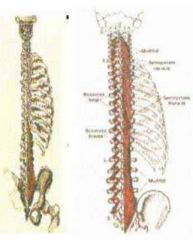
Spinal Muscles:
Multifidus |
|
|
Longissimus: Lumborum
•Origin: L1 – S1 SP’s •Insertion: Ribs 9-12 (Lateral to TP/Inferior Borders) Longissimus: Thoracics •Origin: T1 – T12 TP’s •Insertion: Ribs 1-9 (Adjacent to TP’s at Junction/Inferior) Longissimus: Function •The Erector Spinae group of muscles (spine erectors) runs along both sides of the back of the spine from the sacrum to the occiput (back of head). •Lie slightly away from spine in between the spinalis and iliocostalis. •Bilateral Function: Extension of the spine. •Unilateral Function: Lateral bending of the spine, opposite side rotation. •Depression of the ribs. |
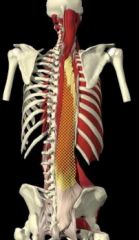
Spinal Muscles:
Longissimus |
|
|
Iliocostalis: Lumborum
•Origin: Sacrum (Posterior/Superior) – L1 SP’s •Insertion: Ribs 6-12 (Inferior Portion) Iliocostalis: Thoracics •Origin: Ribs 7-12 (Superior Portion) •Insertion: Ribs 1-6 (Inferior Border) & C7 TP Iliocostalis: Function •Most lateral column of erector spinae. •Bilateral Function: Extension of the spine. •Unilateral Function: Lateral bending of the spine, opposite side rotation. •Depression of the ribs. |
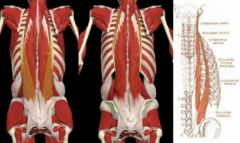
Spinal Muscles:
Iliocostalis |
|
|
Rotatores: Attachments
•Origin: S1 – T1 TP’s •Insertion: L5 – C7 SP’s Rotatores: Function •Part of the transversospinalis group, deep to the erector spinae. Short, diagonal fibers that form a stitch like pattern linking the vertebrae together. •Bilateral Function: Spinal Extension •Unilateral Function: Opposite side rotation. |
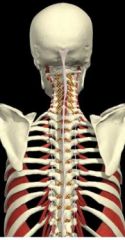
Spinal Muscles:
Rotatores |
|
|
Transverse Abdominis: Lower Fibers
•Origin: Thoraco-lumbar fascia, iliac crest (anterior ¾) and inguinal ligament (lateral 1/3) •Insertion: Linea alba below umbilicus and into pubic symphysis Transverse Abdominis: Upper Fibers •Origin: Cartilage of ribs 1-6. •Insertion: Linea alba superior to umbilicus. Transverse Abdominis: Function •Called the transverse abdominis because its fibers run horizontally from the spine toward the abdomen (like a girdle). Deepest of the four abdominal muscles. •Primary Function: Flattens abdominal wall (forced exhalation) and compresses the viscera (acting like a girdle). •Lower Fibers: aid in rotating the trunk. •Upper Fibers: aid in some flexion and rotation of the trunk. •Weakness: Allows for bulging of anterior abdominal wall, thus increasing lordosis. Also will create lateral bulge in flexion or extension. •Important insertion in Thoraco-lumbar fascia. •Main stabilizer of low back. •Courses anteriorly to the rectus abdominis under the umbilicus: further reinforces fascial support at level most vulnerable to anterior shear. •Activates prior to muscles of the hip and thorax. •Required for all integrated movements. •If weak, can stress all of the other abdominal muscles and the muscles of the mid back. |
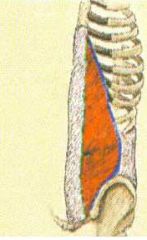
Abdominal Muscles:
Transverse Abdominis |
|
|
Internal Oblique: Anterior Fibers
•Origin: Inguinal ligament (Lateral 2/3) and iliac crest (anterior). •Insertion: With TVA into crest of pubis and into linea alba through an aponeurosis. •Function: Works with the opposite anterior fibers of the external oblique. Internal Oblique: Lateral Fibers •Origin: Iliac crest (middle 1/3) and thoracolumbar fascia. •Insertion: Ribs 10-12 (inferior borders) and linea alba through aponeurosis. •Function: Works with same side lateral fibers of the external oblique. Internal Oblique: Function •Deep & perpendicular to the external obliques. The direction of its fibers are oblique (hence the name) which means that they run diagonally (from the direction of your right hip up towards your left shoulder & vice versa, actually fanning out from the hip. •Internal obliques are strong stabilizers of the trunk, spine & pelvis. •Bilateral Function: Compresses support viscera and flexes the spine. •Unilateral Function: Rotates the vertebral column bringing the thorax backwards or the pelvis forwards (same side rotation). Laterally flexes the vertebral column to the same side. •Internal obliques come forward, up to the rib cage: Pulls inferiorly and posteriorly. •Obliques together create compression with twisting. |
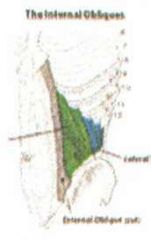
Abdominal Muscles:
Internal Oblique |
|
|
External Oblique: Anterior Fibers
•Origin: Ribs 5-8 (interdigitates) •Insertion: Into linea alba through aponeurosis. External Oblique: Lateral Fibers •Origin: Ribs 9-12 interdigitate with Serratus and lats •Insertion: Iliac Crest (anterior lip) to ASIS into inguinal ligament External Oblique: Function •Direction of its fibers are oblique (hence the name) which means that they run diagonally (from the direction of your right shoulder towards your left hip and vice versa). •Bilateral Function: Flex spine and tilt pelvis posteriorly. •Unilateral Function: Rotate vertebrae to bring thorax forward or pelvis backwards ipsilaterally (opposite side rotation). Laterally Flex the vertebral column to same side. •Along with the other abdominal muscles, the external obliques are strong stabilizers of the trunk, spine & pelvis. •Obliques together create compression with twisting. |
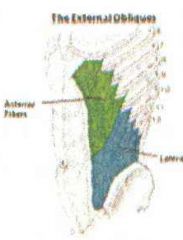
Abdominal Muscles:
External Oblique |
|
|
Pyramidalis: Attachments
•Origin: Pubis (front) & Anterior Pubic Ligament •Insertion: Linea Alba (midway between pubic bone and umbilicus) Pyramidalis: Function •Shaped like a pyramid. It’s located at the base of the rectus abdominis. •Primary Function: Assisting the rectus abdominis in flexion of the trunk. •Tenses the linea alba. •Stabilizes pubic bone: acts as anchor to the linea alba in extreme range of flexion. •If it is weak, it can stress the lower back muscles. |
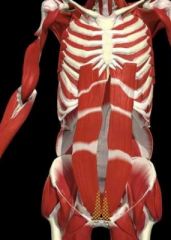
Abdominal Muscles:
Pyramidalis |
|
|
Rectus Abdominis: Attachments
•Origin: Ribs 5-7 Costocartilage •Insertion: Pubic Crest & symphysis. Rectus Abdominis: Function •Most superficial of the abdominal muscles. Fibers are vertical & run from the ribs to the pubic bone. •Primary function is flexion of the trunk; when the pelvis is fixed, the chest will move toward the pelvis and vice-versa. It also aids in lateral trunk flexion and rotation. •Flexes vertebral column. •Approximates thorax and pelvis relative to fixation. •If weak: Inability to flex vertebral column; lose ability for posterior pelvic tilt. •Posture: Prevents anterior pelvic tilt and lordosis. •If weak, lower back and hip flexors can become stressed as well as putting extra burden on the other abdominal muscles (obliques & TVA). |
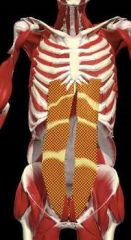
Abdominal Muscles:
Rectus Abdominis |

